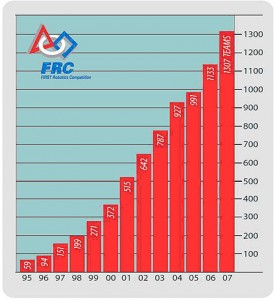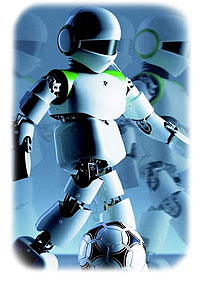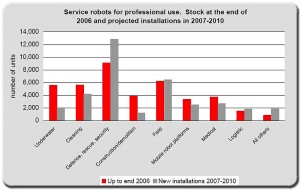Trends in Robotics
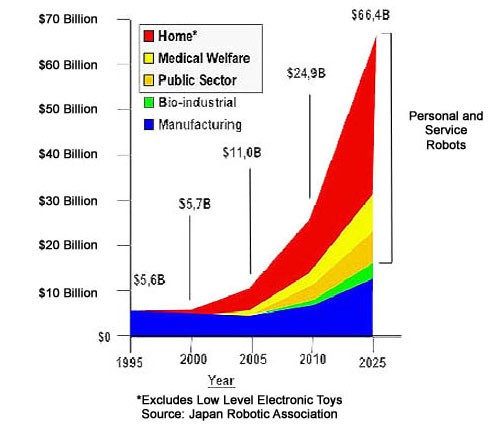
Listed below are just a small fraction of the examples of the robotic revolution. By reading the signs of times, we can clearly see the trends and imagine the future. These trends allow us to take appropriate action to make a better future.
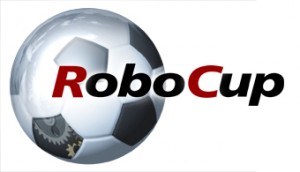 By the year 2050, develop a team of fully autonomous humanoid robots that can win against the human world soccer champion team.™
RoboCup™ is an international research and education initiative. Its goal is to foster artificial intelligence and robotics research by providing a standard problem where a wide range of technologies can be examined and integrated.
The concept of soccer-playing robots was first introduced in 1993. Following a two-year feasibility study, in August 1995, an announcement was made on the introduction of the first international conferences and football games. In July 1997, the first official conference and games were held in Nagoya , Japan . Followed by Paris , Stockholm , Melbourne and Seattle where the annual events attracted many participants and spectators. The 6th RoboCup 2002 was held in Fukuoka , Japan in cooperation with Busan , Korea , while the 7th edition in 2003 took place in Padua , Italy . In 2004 in Lisbon , Portugal . 2005 in Osaka, Japan, 2006 in Bremen, Germany, 2007 in Atlanta, USA, and and now in Suzhou, China. The events were covered by national and international media all over the world.
By the year 2050, develop a team of fully autonomous humanoid robots that can win against the human world soccer champion team.™
RoboCup™ is an international research and education initiative. Its goal is to foster artificial intelligence and robotics research by providing a standard problem where a wide range of technologies can be examined and integrated.
The concept of soccer-playing robots was first introduced in 1993. Following a two-year feasibility study, in August 1995, an announcement was made on the introduction of the first international conferences and football games. In July 1997, the first official conference and games were held in Nagoya , Japan . Followed by Paris , Stockholm , Melbourne and Seattle where the annual events attracted many participants and spectators. The 6th RoboCup 2002 was held in Fukuoka , Japan in cooperation with Busan , Korea , while the 7th edition in 2003 took place in Padua , Italy . In 2004 in Lisbon , Portugal . 2005 in Osaka, Japan, 2006 in Bremen, Germany, 2007 in Atlanta, USA, and and now in Suzhou, China. The events were covered by national and international media all over the world.
Industry
On 9 October 2002, a Service Robotics Group was founded under the auspices of the International Federation of Robotics (IFR). The IFR has recognized, through its national affiliates, the growing commercial activities associated with service robots. At the same time, it has been found that there is little current support for the mostly small and young companies working or entering this area to assist them in market assessment and in raising their profile in the eyes of other industries, the media, and/or government bodies. In response to these facts, IFR operates the Group to further the interests of this emerging industry. The IFR Service Robotics Group is open to all interested service robot companies offering service robot products, components or related services. visit the group’s website at www.ifr.orgEducation & Competition
Robotic competitions are becoming increasingly popular in schools as they give focus and set guidelines for students. FIRST (For Inspiration and Recognition of Science and Technology), which has competitions in America and Canada, seeks "to transform our culture by creating a world where science and technology are celebrated and where young people dream of becoming science and technology heroes." - Dean Kamen, Founder Teachers, parents and students have been drawn to the hands-on learning approach that robotics provides. The number of schools participating in FIRST and other robotics related competitions has risen sharply over the years.I recently participated in a meeting of technology industry executives with Governor Deval Patrick of Massachusetts. He stated that there are 90,000 open jobs in his state and 120,000 people are looking for work. Unfortunately, the twain shall not be met because, in our 21 st century economy, many open positions require technology skills and knowledge that job seekers do not possess. Company executives lament that their businesses could grow faster, if only they could find qualified people. The concern for this growing gap in the workforce echoes throughout my meetings with executives worldwide. Technology companies have thousands of unfilled jobs. Industries from aerospace to utilities to manufacturing anticipate a drastic workforce gap as 50% of their employees become eligible to retire in the next five to ten years. Who will fill these jobs in our economy, where products and services increasingly require a technically literate workforce? Who will be the innovators that improve the quality of life and standard of living of the coming decades? Who will lead the engineering, manufacturing, programming, and research teams? That’s precisely where FIRST and the FIRST Community play a major role. By inspiring students to pursue education and careers in science, engineering, and technology, we are working together with industry, government, educators, parents, and many others to develop the skills that are invaluable today and for the future. The companies and organizations that sponsor FIRST are investing in their future success by supporting teams and events, by supporting the participation of experts, passionate mentors, and by hiring team members, alumni, and FIRST Community members into internships and full-time jobs. - FIRST President, FIRST 2007 Annual Report by Paul R. Gudonis
 By the year 2050, develop a team of fully autonomous humanoid robots that can win against the human world soccer champion team.™
By the year 2050, develop a team of fully autonomous humanoid robots that can win against the human world soccer champion team.™Media
The leader of the PC revolution, Bill Gates, predicts that the next hot field will be robotics. The complete article can be found in Scientific American. Imagine being present at the birth of a new industry. It is an industry based on groundbreaking new technologies, wherein a handful of well-established corporations sell highly specialized devices for business use and a fast-growing number of start-up companies produce innovative toys, gadgets for hobbyists and other interesting niche products. But it is also a highly fragmented industry with few common standards or platforms. Projects are complex, progress is slow, and practical applications are relatively rare. In fact, for all the excitement and promise, no one can say with any certainty when--or even if--this industry will achieve critical mass. If it does, though, it may well change the world. Of course, the paragraph above could be a description of the computer industry during the mid-1970s, around the time that Paul Allen and I launched Microsoft. Back then, big, expensive mainframe computers ran the back-office operations for major companies, governmental departments and other institutions. Researchers at leading universities and industrial laboratories were creating the basic building blocks that would make the information age possible. Intel had just introduced the 8080 microprocessor, and Atari was selling the popular electronic game Pong. At homegrown computer clubs, enthusiasts struggled to figure out exactly what this new technology was good for. But what I really have in mind is something much more contemporary: the emergence of the robotics industry, which is developing in much the same way that the computer business did 30 years ago. Think of the manufacturing robots currently used on automobile assembly lines as the equivalent of yesterday's mainframes. The industry's niche products include robotic arms that perform surgery, surveillance robots deployed in Iraq and Afghanistan that dispose of roadside bombs, and domestic robots that vacuum the floor. Electronics companies have made robotic toys that can imitate people or dogs or dinosaurs, and hobbyists are anxious to get their hands on the latest version of the Lego robotics system. Meanwhile some of the world's best minds are trying to solve the toughest problems of robotics, such as visual recognition, navigation and machine learning. And they are succeeding. At the 2004 Defense Advanced Research Projects Agency (DARPA) Grand Challenge, a competition to produce the first robotic vehicle capable of navigating autonomously over a rugged 142-mile course through the Mojave Desert, the top competitor managed to travel just 7.4 miles before breaking down. In 2005, though, five vehicles covered the complete distance, and the race's winner did it at an average speed of 19.1 miles an hour. (In another intriguing parallel between the robotics and computer industries, DARPA also funded the work that led to the creation of Arpanet, the precursor to the Internet.) What is more, the challenges facing the robotics industry are similar to those we tackled in computing three decades ago. Robotics companies have no standard operating software that could allow popular application programs to run in a variety of devices. The standardization of robotic processors and other hardware is limited, and very little of the programming code used in one machine can be applied to another. Whenever somebody wants to build a new robot, they usually have to start from square one. Despite these difficulties, when I talk to people involved in robotics--from university researchers to entrepreneurs, hobbyists and high school students--the level of excitement and expectation reminds me so much of that time when Paul Allen and I looked at the convergence of new technologies and dreamed of the day when a computer would be on every desk and in every home. And as I look at the trends that are now starting to converge, I can envision a future in which robotic devices will become a nearly ubiquitous part of our day-to-day lives. I believe that technologies such as distributed computing, voice and visual recognition, and wireless broadband connectivity will open the door to a new generation of autonomous devices that enable computers to perform tasks in the physical world on our behalf. We may be on the verge of a new era, when the PC will get up off the desktop and allow us to see, hear, touch and manipulate objects in places where we are not physically present…Giants Join the Revolution
Microsoft Robotics Developer Studio
Microsoft® Robotics Studio is a Windows-based environment for hobbyist, academic and commercial developers to create robotics applications for a variety of hardware platforms. The Microsoft Robotics Studio includes a lightweight REST-style, service-oriented run-time, a set of visual authoring and simulation tools, as well as tutorials and sample code to help you get started. The Visual Programming Language enables anyone to create and debug robotics programs very easily. Just drag and drop blocks that represent services, and connect them up. You can even take a collection of connected blocks and reuse them as a single block elsewhere in your program.Google Lunar X-Prize
The Google Lunar X PRIZE is a $30 million international competition to safely land a robot on the surface of the Moon, travel 500 meters over the lunar surface, and send images and data back to the Earth. Teams must be at least 90% privately funded and must be registered to compete by December 31, 2010. The first team to land on the Moon and complete the mission objectives will be awarded $20 million; the full first prize is available until December 31, 2012. After that date, the first prize will drop to $15 million. The second team to do so will be awarded $5 million. Another $5 million will awarded in bonus prizes. The final deadline for winning the prize is December 31, 2014.Where We Can Find Robots Today
Japan is currently home to about half the robots worldwide. The Japan Robotics Association has predicted an ever increasing demand for robots. A large fraction of market demand will be specifically for personal and service robots. Although a large number of robots are used in defence, rescue and security, Service robots can be found in a variety of different disciplines: The number of personal and domestic robots will rise dramatically over the coming years. The number of new robots built solely between 2007-2010 used in entertainment will far exceed the number of robots currently being used.Thanks for helping to keep our community civil!
Notify staff privately
You flagged this as spam. Undo flag.Flag Post
It's Spam
This post is an advertisement, or vandalism. It is not useful or relevant to the current topic.
This post is an advertisement, or vandalism. It is not useful or relevant to the current topic.
You flagged this as spam. Undo flag.Flag Post



